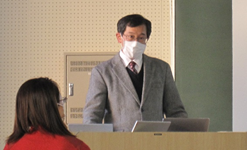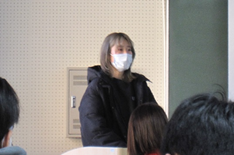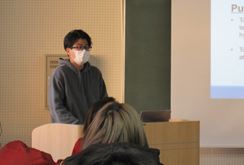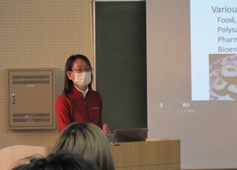HOSTY Association (Graduate School of Advanced Science and Engineering)
Email: bprc*hiroshima-u.ac.jp (Please replace*with @)
Date : February. 20, 2023
Place: Engineering 110 Lecture Room, Higashi-Hiroshima Campus, Hiroshima University
Program
Chair & Commentary: Yukihiko MATSUMURA
Professor, Graduate School of Advanced Science and Engineering, Hiroshima University

Lecture: Natsuki WATANABE
B4 student, School of Engineering, Hiroshima University
“HYDROTHERMAL CARBONIZATION OF FOOD WASTE.”
Incineration is the main method used to dispose of food waste. However, since food waste contain a lot of water, a lot of energy is used to evaporate the water during incineration, resulting in poor energy efficiency. Hydrothermal carbonization is a technology in which reactions such as hydrolysis and dehydration are carried out by heat-treating an object in high-temperature, high-pressure water. There is no need for a drying process of the raw material, and it is suitable for treating materials with high water content. In this study, hydrothermal carbonization was performed using model food waste at different temperatures and reaction times to determine how much carbon remained.

Lecture: Yuito SUGANUMA
M2, Graduate School of Advanced Science and Engineering, Hiroshima University
“COMPARATIVE STUDY OF AMMONIA PRODUCTION FROM URIC ACID, PROTEIN, AND CHICKEN MANURE BY HYDROTHERMAL TREATMENT.”
Biomass, such as livestock excrement, poses problems of air and water pollution. Methane fermentation is used to treat this properly and utilize it effectively. However, during methane fermentation, nitrogen in the biomass becomes ammonium ion, which inhibits fermentation. Therefore, it was proposed that the nitrogen in the biomass was hydrothermally treated to be converted into ammonium ion in advance and to be recovered before methane fermentation. To understand the ammonia production behavior by hydrothermal treatment, uric acid, and protein, which are abundant in chicken manure as a nitrogen source, were treated by themselves. The reaction pathway of chicken manure could be explained by their decomposition behavior.

Lecture: Aki KATO
Associate Professor, Takehara Fisheries Research Station, Setouchi Field Science Center, Graduate School of Integrated Sciences for Life, Hiroshima University
“BASIC KNOWLEDGE ON SEAWEED RESOURCES AND CULTIVATION .”
Seaweeds have been collected and utilized as human food and medicines in East Asia for more than 1,000 years. The industrial-scale cultivation began in the mid-20th century with growing understanding of biological characteristics of major economic seaweeds. Recently, seaweeds have come to account for about a quarter of the world's aquaculture production. In this seminar, basic contents of taxonomy, ecology, and physiological characteristics of seaweeds related to cultivation are introduced.


 Home
Home



